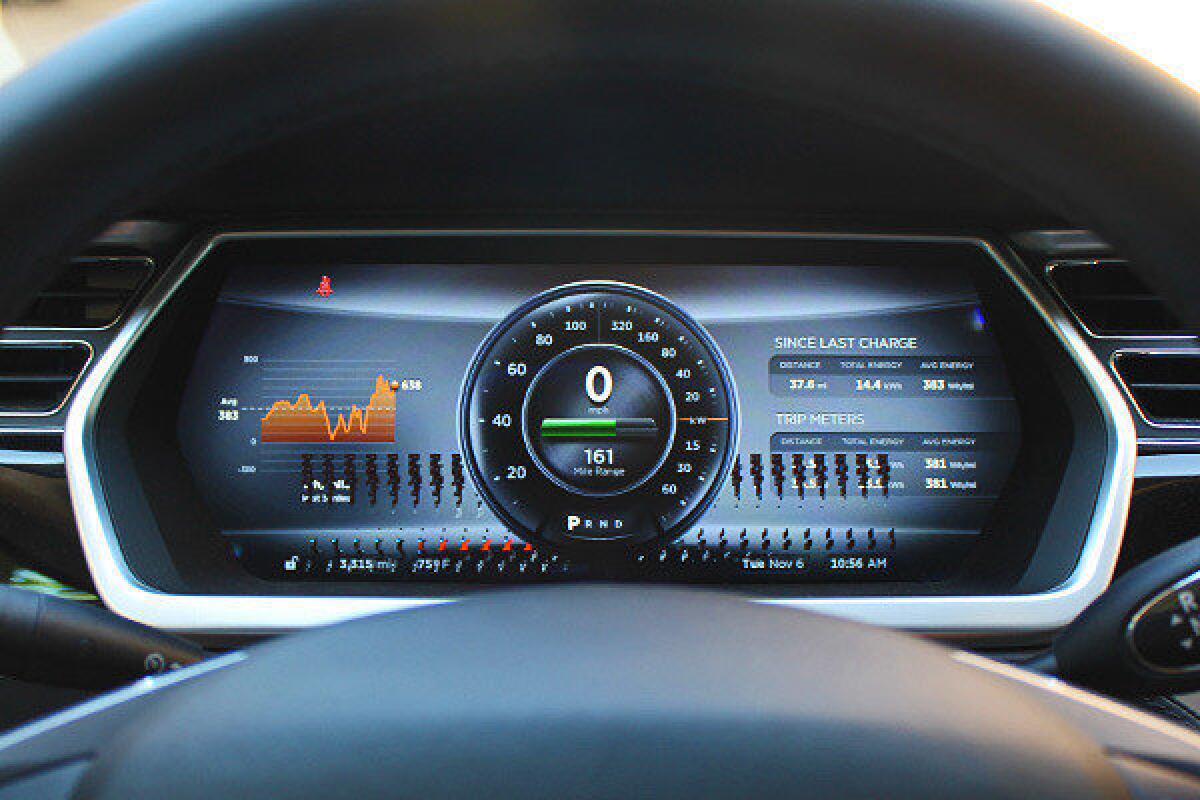Updated:] Times Test Garage: Tesla Model S reveals some gremlins

- Share via
Nov. 9, 2012 update: Tesla has responded to several of these issues. Please see below for details.
Beyond the all-electric drivetrain on the Tesla Model S, a host of interior gadgets makes the car unique – most notably the giant in-dash screen, for navigating both the Web and the highways.
But we’ve noticed a few electronic gremlins so far in our weeklong test drive. Without warning or provocation, the lower part of the dash display suddenly developed an odd pixelation glitch (see above photo). Turning the car off and back on failed to correct the problem. I’ve reached out to the folks at Tesla Motors, and they’re checking in on potential remedies. Stay tuned. Update: Tesla tells me this is a glitch that has been resolved in a software update available to customers in the coming weeks. Until then, the company recommends manually resetting the screen. I did so and the reset worked, correcting the problem.
Speaking of the car’s on/off switch, it doesn’t have one. When you open the doors after unlocking the Model S, the car’s systems automatically start up (stereo, climate control, interior and exterior lighting). When you put your foot on the brake, the car’s drivetrain fires up and is ready to move.
Photos: Details of the Tesla Model S
Once you reach your destination, you just get out and walk away; the car turns itself off. This is a little disconcerting. At one point, I didn’t close the door all the way (completely my fault, though they are harder to close than other cars). This caused the stereo and climate control to remain on until I returned, potentially draining the battery. The air conditioning runs off the car’s power source, while ancillary functions such as the stereo and the display screens run off a separate 12-volt battery that is recharged by the large battery. Update: Tesla says the electric powertrain (high-voltage battery) shuts off automatically shortly after the driver exits the vehicle, though the displays and radio may remain on. In this instance (the door not closing all the way) the displays will remain on for a maximum of 30 minutes and will then turn off automatically. If the climate control were to remain running during this time, Tesla says it would drain the high-voltage battery by only 2 percent.
You can manually turn the car off, but only with a virtual button buried under several layers of sub-menus on the touchscreen. And if you hit that button before you open the door to get out, all the systems fire right back up when the door opens.
Finally, this car doesn’t have heated seats – a feature you might expect in an $80,000 car. If that seems like a minor oversight, consider that heated seats would be a much more efficient way to heat the cabin than the climate control system, which sucks battery life from the electric powertrain and reduces the car’s driving range. And that’s why nearly every other EV on the road, including Ford Focus EV, Toyota RAV4 EV, Honda Fit EV and Nissan Leaf, comes with heated seats as standard equipment.
ALSO:
Times Test Garage: Details on the Tesla Model S
Sitting shotgun in Porsche’s upcoming plug-in hybrid supercar
Maserati unveils photos of 2014 Quattroporte ahead of Detroit Auto Show debut
More to Read
Inside the business of entertainment
The Wide Shot brings you news, analysis and insights on everything from streaming wars to production — and what it all means for the future.
You may occasionally receive promotional content from the Los Angeles Times.











